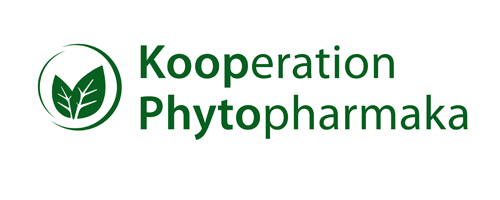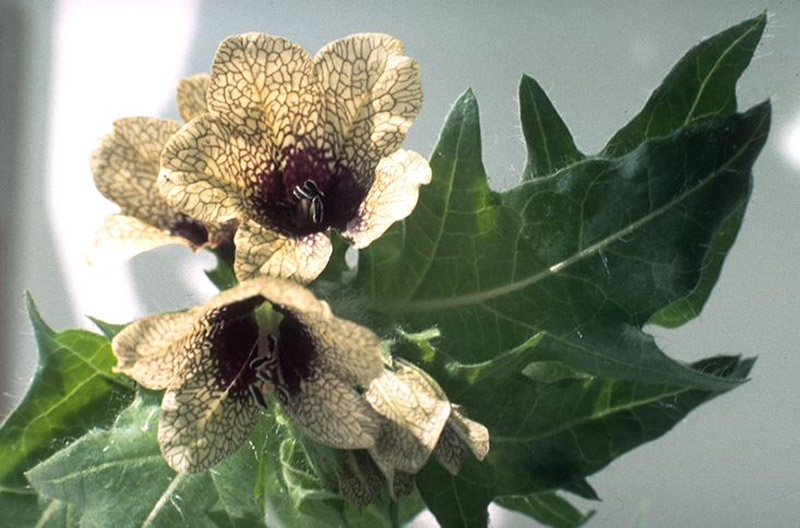Botanical name
Hyoscyamus niger L.
Family
Solanaceae
Common name
Henbane, Black henbane, Stinking nightshade, Hog bean, Devil’s eyes
Information about the plant
Henbane is a poisonous plant native to Europe (!), it is found in Asia as far as Mongolia and northern India; it also grows in North Africa and has been introduced to North America and Australia. In Germany, it mainly grows in warmer regions, in bright, sunny places, often on rubble areas, on roadsides and at the base of walls.
The genus name Hyoscyamus can be translated as "hog bean", from the Greek 'hyos' (= hog) and ‘kyamos’ (= bean). This refers to the capsule fruit, the effects of which on pigs are described in different ways. One version is that it is particularly poisonous to pigs, while another says that pigs can eat the capsule without being harmed. The species epithet niger (Latin 'niger' = black) refers to the dark red-purple spots in the throat of the white-yellow flowers. "Henbane" probably comes from the language of the ancient Celts, who worshipped the god Belenos.
Henbane is annual to biennial, up to 50 cm in height, with a glandular, shaggy hairy stem, thus somewhat sticky to the touch. The leaves are 20 cm long, with large, lobed margins. The dirty-yellowish, funnel-shaped, five-lobed corolla is crossed by dark-purple reticulated veins and stands in a jug-shaped, glandular, haired calyx with five-pointed teeth. The fruit is a bulbous lidded capsule with up to 200 kidney-shaped, gray-brown seeds. Flowering time is from June to October.
Medicinally used parts of plants (herbal drug)
The dried leaves or the dried leaves with flowering and occasionally fruiting branch tips (Hyoscyamus leaves/henbane leaves - Hyoscyami folium) are used.
The commercially available drug comes from wild harvests in Eastern European countries.
Constituents of the herbal drug
Henbane contains potent tropane alkaloids, the most important of which are (-)-hyoscyamine and (-)-scopolamine. The tropane alkaloids are responsible for the toxicity of the plant.
Quality of the drug
The two Ph. Eur. monographs, Hyoscyamus leaves (Hyoscymi folium), and standardized Hyoscyamus powder (Hyoscyami folii pulvis normatus), were no longer included in the Eur. Ph. 4.0 in 2002. Consequently, no pharmacopoeial quality description is available for hyoscyamus leaves (Hyoscyami folium). The European Pharmacopoeia contains a monograph, "Hyoscyamus for homeopathic preparations (Hyoscyamus niger ad praeparationes homoeopathicas)".
Medical applications
Recognised medical use
Henbane is a very old medicinal plant and was used in the past as a sleep aid, the fresh leaves were also used as painkilling poultices. In the Middle Ages, doctors used henbane, like chloroform, as an aneaesthetic, and it was also used for toothache, headache, dysentery and insomnia. It was also used in religious ceremonies. In the Middle Ages, it was considered a "witch plant" and was an ingredient in "flying ointments", with the help of which the so-called witches could rise into the air. In many confessions of women under torture, henbane was mentioned as a magical substance.
Due to the narrow therapeutic range (strong poisonous effect of the tropane alkaloids!), henbane is no longer used today. The alkaloids contained in henbane (hyoscyamine, scopolamine) are strongly effective drugs in its pure form. There is no scientific evidence for a phytotherapeutic use of henbane, which is why HMPC stopped producing a monograph back in 2011. ESCOP has not produced a monograph either. In 1988, Commission E produced a monograph, where the indication was: spasms of the gastrointestinal tract; according to current knowledge, however, henbane should no longer be used phytotherapeutically.
Traditional use
Due to the content of strongly active alkaloids, a classification of henbane leaves/hyoscyamus leaves as a traditional herbal medicinal product within the terms of § 39a AMG is prohibited.
Herbal drug preparations in finished dosage forms
None; for the indication of atropine (racemic hyoscyamine) and scopolamine, see the monographs Belladonna and Datura, respectively.
Dosage
Not applicable
Preparation of a tea
Not applicable
Notes
Hyoscyamus leaves/henbane leaves are poisonous (strong central effect!), therefore the use of the drug or the finished medicinal products should be considered only under the supervision of a doctor. Children and adolescents under 18 years of age must not use hyoscyamus leaves/henbane leaves.
Further literature
Commentary on the European Pharmacopoeia (Hyoscyamus for homeopathic preparations, Nr. 2091)


